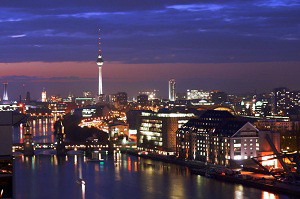
Sightseeing Berlin
Streets as Unter den Linden and Friedrichstrasse, squares as Alexanderplatz and Potsdamer Platz, big parks and charming areas: Berlin is a wonderful area to discover by bike or on feet. Next to Brandenburger Tor and Checkpoint Charlie (mentioned in the Travel Guide section), you can visit places as the Holocaust memorial, the Siegessäule or the East Side Gallery. These attractions all tell their own story about the long and special history of Berlin.
Unter den Linden
Unter den Linden (Under the lime trees) is the main boulevard of Berlin. It stretches from Brandenburger Tor at the west side of the huge Tiergarten park to Alexanderplatz in former East Berlin. The Prussian kings and Berlin aristocracy used this boulevard to show off themselves and to watch each other. Although the socialist times have changed some of that historic atmosphere, you still see many special buildings in the boulevard, such as Humboldt University, the national opera, and Hotel Adlon.
Prenzlauerberg
Prenzlauerberg originally made part of East Berlin and was Berlin’s creative and alternative heart after the fall of the Wall and the reunification of Berlin and Germany. In the following decades, it developed in one of the most popular and hip areas of the city. Now, Prenzlauerberg is an appreciated residential area, but also loved by visitors for its bars and cafes. For instance, Kollwitzplatz is a good place to go for a drink or a bite.
Kreuzberg
This multicultural area to the south of the river Spree is the cultural heart of this city that offers so much. This is one of the areas where migrants, mostly from Turkey, started to settle, so the area has a distinct multicultural atmosphere.
Siegessäule
The Siegessäule or Victory column was erected by emperor William I to remember the victories of the young Germany in the unification wars in the 1860s and 1870s. It is possible to climb the 285 stairs up to a height of 50 meters (of a total height of 67). Here, you can pay a closer look to the golden goddess of victory. It is also a great spot to enjoy a panorama over many parts of Berlin.
Strasse des 17. Juni
Denkmal für die ermordeten Juden Europas
Coming to terms with the Holocaust hasn’t been easy for the Germans, who have strict regulations to forbid discriminating political parties and to protect privacy. The creation, officially named "Monument for the murdered Jews of Europe" bears the signature of the American architect Peter Eisenman and attempts to offer a place for memorial and reflection. The installation consists of many concrete blocks put in straight lines where you can walk around and feel lost in between them. The stones are compared with tombs for the nameless victims of the Holocaust. The site also features an impressive museum on the history and organisation of the deportation and extermination of Jews in entire Europe.
Cora-Berliner-Straße 1
East Side Gallery
The East Side Gallery of 1.3 kilometres is the longest part of the Berlin Wall that is still standing. It has been opened in 1990, a year after the fall of the Wall. The organisation gave artists from many different countries the possibility to express their view about Die Wende (The Change; that is, the fall of the Wall and the end of communism) in graffiti. The most famous image on the wall is the kiss between Soviet leader Brezjnev and East German Honecker. The current gallery does not contain the original images from 1990, but is a newly renovated project from 2009 which remembers the 20th anniversary of the fall of the Wall
East Side Gallery, between Ostbahnhof (Eastern station, Koppenstrasse 3 and Oberbaum bridge, Am Oberbaum)
Martin Gropius Bau
This particular building in the Friedrichstadt area is named after its designer Martin Gropius who built this architectonic jewel in Italian Renaissance style at the end of the 19th century. The building originally was used as a museum for Asian art and was severely damaged in the Second World War. Renovations started in the 1970s. Since the completion, the building has been used for temporary exhibitions of modern art and old artefacts. For instance, over the last years, there have been exhibitions of artist as Man Ray and Frida Kahlo and the ancient Egyptian and Mexican civilisations.
Niederkirchnerstraße 7
